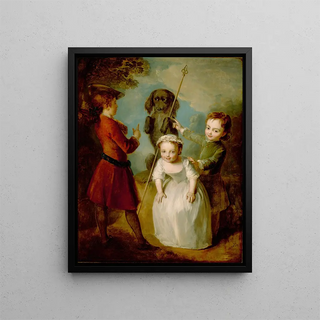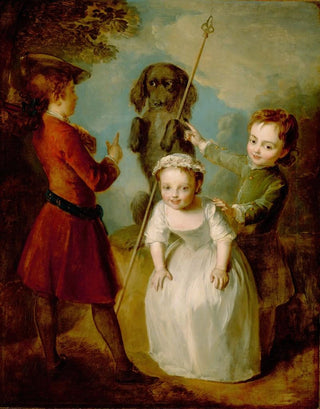Art print | Playing at soldiers - Philippe Mercier


View from behind

Frame (optional)
Play at Soldiers - Philippe Mercier – Engaging Introduction
The artwork "Play at Soldiers" by Philippe Mercier immerses us in a world filled with nostalgia and delicacy. This painting, which evokes childhood memories and innocent games, invites us to contemplate a moment frozen in time. The characters, captured in a playful scene, embody a certain lightness, while revealing the depth of human emotions. Mercier's skillfully orchestrated composition, with its soft colors and play of light, captures attention and evokes a feeling of tenderness. Through this piece, the artist offers us a glimpse into daily life in the 18th century, while celebrating the simple joy of childhood.
Style and uniqueness of the artwork
Philippe Mercier's style is distinguished by his ability to blend realism with a touch of romanticism. In "Play at Soldiers," every detail is carefully considered to create a warm and inviting atmosphere. The children's faces, expressive and lively, demonstrate exceptional technical mastery, while decorative elements such as toys and costumes add a historical dimension to the scene. Mercier excels in the art of visual storytelling, using color and light to evoke complex emotions. The way he captures the movement of children playing, as well as the interaction between characters, gives the piece a unique dynamism. This painting does not merely depict a moment of play; it immortalizes a fragment of childhood innocence, while inviting us to reflect on the passage of time and the fragility of these precious moments.
The artist and his influence
Philippe Mercier, a French-born artist, established himself in the 18th-century art scene through his talent and sensitivity. Trained in the workshops of the great masters of his time, he developed a personal style that set him apart. His work, marked by meticulous attention to detail and a deep understanding of human emotions, influenced many contemporary and later artists. Mercier was able to capture the essence of daily life, transforming ordinary scenes into true works of art. His approach, which blends realism and sensitivity

Matte finish

View from behind

Frame (optional)
Play at Soldiers - Philippe Mercier – Engaging Introduction
The artwork "Play at Soldiers" by Philippe Mercier immerses us in a world filled with nostalgia and delicacy. This painting, which evokes childhood memories and innocent games, invites us to contemplate a moment frozen in time. The characters, captured in a playful scene, embody a certain lightness, while revealing the depth of human emotions. Mercier's skillfully orchestrated composition, with its soft colors and play of light, captures attention and evokes a feeling of tenderness. Through this piece, the artist offers us a glimpse into daily life in the 18th century, while celebrating the simple joy of childhood.
Style and uniqueness of the artwork
Philippe Mercier's style is distinguished by his ability to blend realism with a touch of romanticism. In "Play at Soldiers," every detail is carefully considered to create a warm and inviting atmosphere. The children's faces, expressive and lively, demonstrate exceptional technical mastery, while decorative elements such as toys and costumes add a historical dimension to the scene. Mercier excels in the art of visual storytelling, using color and light to evoke complex emotions. The way he captures the movement of children playing, as well as the interaction between characters, gives the piece a unique dynamism. This painting does not merely depict a moment of play; it immortalizes a fragment of childhood innocence, while inviting us to reflect on the passage of time and the fragility of these precious moments.
The artist and his influence
Philippe Mercier, a French-born artist, established himself in the 18th-century art scene through his talent and sensitivity. Trained in the workshops of the great masters of his time, he developed a personal style that set him apart. His work, marked by meticulous attention to detail and a deep understanding of human emotions, influenced many contemporary and later artists. Mercier was able to capture the essence of daily life, transforming ordinary scenes into true works of art. His approach, which blends realism and sensitivity






